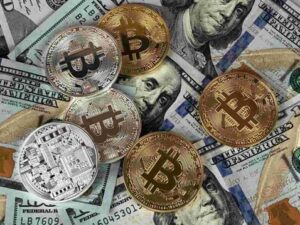The Federal Reserve initiated a new cycle of interest rate cuts last week. This makes it the first time in over four years that the U.S. central bank has reduced borrowing costs. Historically, these rate cuts have had a significant influence on global financial markets such as stocks and cryptocurrency. Investors generally view lower interest rates as a positive sign to invest in other assets. Rate cuts are traditionally favorable for stocks, bonds, and the real estate market. The latter often benefits from increased demand for mortgages because of the cheaper cost of borrowing. Interest rate reductions also tend to boost commodity prices. Gold has reached a new record high, while crude oil has seen a significant recovery.

Historical Impact of Federal Reserve Interest Rates on Cryptocurrency Markets
Interest rates are one of the Federal Reserve’s key tools for shaping the economy. Lower rates help trigger economic growth because they make borrowing cheaper. On the other hand, a higher rate slows activity by making credit more expensive. This strategy is often used to fight inflation.
During the last tightening cycle, the Fed raised interest rates 11 times. However, markets started to take notice of the Fed’s commitment to tightening monetary policy in November 2021, when cryptocurrencies and many high-risk stocks hit their peak.
When the Fed shifted to a more restrictive monetary stance in 2022, both equity markets and cryptocurrencies saw significant declines.
Cryptocurrency prices struggled throughout 2022 as interest rates continued to climb. However, when rates started to level off, crypto prices hit their lowest point and began to recover in 2023. The launch of Bitcoin ETFs and the recent Bitcoin halving have helped propel Bitcon’s price to where it is now. Bitcoin reached an all-time high in March 2024, and the recent rate cuts could help propel the market past this mark.
Bitcoin and Other Cryptocurrencies Rise After the Fed Cut Rates
Cryptocurrency prices surged in mid-September during a larger market rally after the Federal Reserve’s half-percentage-point interest rate cut. The price of bitcoin was hovering around the $60,000 mark and then jumped by 5% to trade at $63,255.00. This gain added to a continued rally that started before the Fed’s decision. However, like stocks, Bitcoin initially jumped and then pulled back as traders processed the news.
Bitcoin acts as both a hedge and a risky asset, and its strongest long-term correlation is a negative relationship with the U.S. dollar. When the Federal Reserve lowers interest rates, it increases liquidity in the market. This reduces borrowing costs and encourages investments in riskier assets like Bitcoin. However, this increased liquidity also adds to Bitcoin’s volatility. Investors often turn to Bitcoin as a hedge against inflation, pushing prices higher. But this speculative buying can lead to sharp price drops if inflation stabilizes or other assets become more attractive.
The anticipation around future rate changes also adds an extra layer of uncertainty around Bitcoin’s potential as a long-term store of value. Investors who trade bitcoin on a modern crypto trading platform see Bitcoin as protection against inflation and must understand its sensitivity to external factors, such as shifts in government fiscal policies or global financial fluctuations.
From a technical standpoint, Bitcoin has shown a strong increase on the linear chart. The price experienced a highly volatile movement before it changed direction. A notable pattern seen is the double top formation in 2021, which resulted in a significant price drop. Afterward, a symmetrical broadening wedge pattern emerged, driving prices back up. Bitcoin is forming a descending broadening pattern, which is seen as a bullish signal if prices break above $72,000. However, until this level is surpassed, the Bitcoin market remains uncertain.
Bitcoin increased by 6% in September, which is usually its weakest month of the year. Bitcoin’s highest price, recorded in March 2024, is only 12 percent higher than the current price.
With the recent interest rate cut by the Federal Reserve, there’s a chance Bitcoin could see strong performance in the fourth quarter. However, some investors worry that the Fed’s larger-than-expected rate reduction suggests that policymakers are more concerned about the economy than it seems. On the other hand, others are focused on the fact that easier borrowing conditions and increased liquidity could boost prices.

Crypto Market Liquidity Surges After the U.S. Interest Rate Cut
The interest rate cut by the U.S. Federal Reserve has also brought increased liquidity into the market. According to CoinGecko, the global crypto market cap grew by 1.9% to reach $2.23 trillion. Daily trading volume also surpassed $120 billion.
The boost in liquidity came after the U.S. Fed announced a 50-basis-point rate cut at 18:00 UTC on September 18. Total crypto open interest increased by 4% in the last 24 hours and now stands at $58.7 billion. An increase in open interest often signals FOMO (fear of missing out), which can lead to more liquidations and cause significant price swings. Investor sentiment has also notably improved at this time.

How the Fed’s Rate Changes Impact Bitcoin Prices
The price of Bitcoin tends to be very sensitive to the changes in the Federal Reserve’s interest rates. Lower rates translate to increased liquidity and cheaper borrowing costs. This makes Bitcoin more attractive to investors seeking alternative options, especially in times of inflation or concerns about the weakening of the U.S. dollar. Nonetheless, Bitcoin is still very much volatile and speculative and often experiences price fluctuations when economic conditions change.






